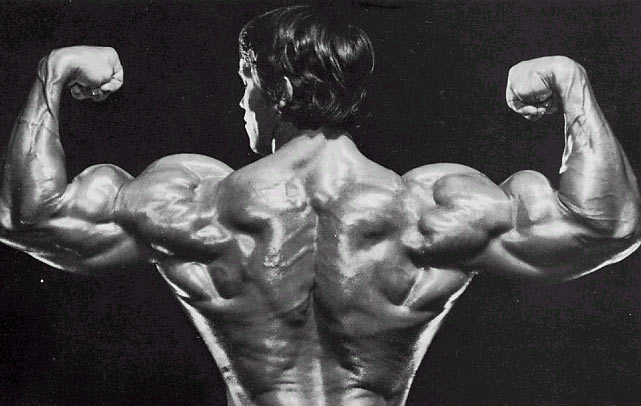
A common question among lifters is how often they should work out. There is a natural fear of overtraining by doing too much, and leaving muscle gains on the table by doing too little. I always recommend to my clients to train more often than you don’t, which obviously works out to a minimum of 4 days per week.
Given people’s schedules and overall commitment, a 4 day per week training split is pretty common. But the question then becomes how to get the most out of your time in the gym; not only in each individual workout but in the structure of the overall plan itself.
Training routines can range from full body (i.e. training every muscle group during each workout) to split body training (i.e. training one to two muscle groups per workout).
The two factors that determine the best 4 day workout plan for muscle growth are advancement in training and priorities with regard to individual muscles. Advanced trainees would benefit more from high frequency training like full body or upper/lower, while beginners can still maximize muscle growth with split body part training.
Split Training
Split training, often referred to as bro splits, is where an individual focuses on one to two major muscle groups in isolation during the entire workout. For example, they might have a workout dedicated to chest, the next day dedicated to back, and so on.
Split training is more beneficial for beginner to intermediate lifters. The reason is that at a certain point an advanced lifter will have to hit a muscle group more often to see results. Once a week just isn’t enough anymore, even if the workouts are grueling.
Bro splits are the most common training routine for anyone looking to build muscle. Ask anyone in your gym what they’re working on that day and you’re far more likely to get an answer like “chest” or “legs” than you are “full body.”
Most people start with this type of training split and never change. It’s worked up to this point so they figure there’s no need to alter the routine. But in reality, the muscle gains have probably slowed considerably, and they’re coasting on the gains made in their first two years of working out.
While bro splits may be suboptimal at a certain point for overall muscle growth, they may be beneficial for someone looking to focus on one particular muscle. This is particularly true for smaller muscles.
Imagine dedicating an entire day to triceps. Triceps could get lost in the mix with full body training, but now they are the focus of an entire workout. You could hit the muscle from all different angles; utilizing different cable attachments for pushdowns and different grips for skull crushers. Even though it’s still just once per week, think of the muscle pumps and the overall amount of workout volume you could achieve.

Split training is also a great way to learn and implement new exercises into a routine. With higher frequency training like full body, you want to get the most out of each exercise. You may only be hitting chest once or twice in the entire session, so it’s more likely you’d choose a flat or incline bench press.
With split training you can afford to experiment more. You can try a decline bench on the smith machine or a funky pushup variation someone taught you. Even if you didn’t like the way it felt it’s no big deal, you still have 4 or 5 more exercises that you know have worked in the past. In the midst of a full body workout you may be less likely to take that chance for fear of wasting time.
| Monday | Legs |
| Tuesday | Chest |
| Wednesday | Off |
| Thursday | Shoulders and Back |
| Friday | Off |
| Saturday | Arms |
| Sunday | Off |
Upper/Lower Split
An upper/lower split alternates between upper body training and lower body training twice per week. This split is particularly beneficial for someone looking to bring up their legs, as most people couldn’t imagine doing legs twice per week.
This is a pretty dramatic shift from the bro split. Leg days remain the same; they’re just done more often. But it can be a challenge to go from one body part per workout to an entire upper body routine. It takes planning to make sure each muscle group gets their fair shake.
At the same time, you shouldn’t be afraid to give a muscle group more attention if you want to improve it above all else. You’d simply add more sets or an additional exercise for whatever muscle that is. Just make sure it isn’t at the immense expense of another muscle, for fear of an imbalance occurring.
Full Body Training
The most challenging transition is from a bro split to full body training. This is particularly the case from a mental perspective.
Mentally, there is an inherent fear that you’re not “doing enough” per muscle group in a given workout when going full body. Odds are you’re only hitting a specific muscle once, maybe twice, per workout. This is quite different than doing 4-5 exercises on a chest day.
However, the volume will even out over the course of the week. A full body workout that is performed 4 times per week will result in a minimum of 4 exercises per body part if structured properly. The benefit of full body training is that each exercise is performed to a given muscle’s full capacity.
Let’s say you perform one chest exercise per workout in a 4 day full body program; flat bench, incline bench, flat dumbbell flyes, and cable crossovers. If you perform all of these in one chest day, by the time you get to cable crossovers you would be quite fatigued. You wouldn’t be able to give maximum effort even if you wanted to.
However, during each full body workout, the exercise dedicated to each muscle gets your full attention. The day you do cable crossovers you will be totally fresh, as that is the only chest exercise for that workout. Even if you worked secondary muscles like shoulders prior, it wouldn’t affect your performance much. You can truly give it your all, which will in all likelihood lead to heavier weight and improved mind muscle connection (see mechanical tension later in the article).
Even if it’s the very last exercise you do in that full body workout, your chest muscles would not be fatigued. You may have some general fatigue just from the act of exercising for about an hour. But it wouldn’t be a major limiting factor for that particular exercise.
This goes along with another mindset shift that needs to occur when moving from split training to full body training. When following a split training routine, there can be an inherent conservative approach to certain exercises.
In the back of your mind there may be a thought to not push yourself, with the idea being that you still have to get through more exercises utilizing the same muscle. There may be hesitancy to go heavier or push out a few more reps. You’d feel the need to leave something in the tank.
With full body workouts you don’t have to worry. For something like barbell bicep curls you can truly push yourself, as it is likely the only bicep exercise you’ll do for that day. You could push out a few more reps or even go to failure in certain situations.
Full body plans are also great if you go to the gym during peak hours. You no longer have to dread Mondays, a.k.a. international chest day. If all benches are taken it’s no big deal, you can work on something else in the meantime.
Full body training also gives greater blood flow throughout the entire body. By working each muscle evenly, there is more systemic blood flow compared to it going to one specific muscle. It’s been hypothesized that this could result in a greater overall calorie burn. Given that some studies have shown a greater body fat reduction in full body training compared to split training, this seems like an accurate assessment.
Factors That Influence Muscle Growth
The main factor that influences muscle growth is mechanical tension, or the ability to use muscles to generate force. In layman’s terms this basically means having good form on exercises while utilizing a weight that is challenging.
Beyond that the next biggest factor is volume. Volume has been referenced a few times already, and there are two main ways to define it. The most common mathematical formula is weight lifted x reps x sets. But another easier way is simply to count the number of working sets for a given muscle group. A working set is any set performed that is not a warm up (i.e. the weight or load is high enough to constitute a challenging set).
You could even make the argument that mechanical tension and volume go hand-in-hand, since you would need your muscles to produce more force in order to increase volume. This is the case whether you’re increasing volume by adding more weight or more sets.
What about if volume is equated between a full body routine and a split routine? Is one more beneficial than the other? When it comes to strength it seems that they are both pretty equal, however for muscle growth studies have been more favorable towards full body routines.
General Recommendations
If you’re working out with proper form, utilizing challenging weight, while getting enough volume per muscle group over the course of a week, you’ve satisfied 90% of what’s needed to get the most out of each gym session.
It’s important to keep that statement in mind, as many people get lost in the details of advanced workout programming and forget what’s truly important; working out hard and smart with consistency.
With that being said the research suggests a benefit toward higher frequency training, whether it be upper/lower or full body, in intermediate to advanced lifters. There’s no official definition for intermediate and above, but most would consider consistently lifting for 2-3+ years to be intermediate.
A beginner could benefit from any workout program listed in this article. A beginner is very sensitive to muscle growth, as they are essentially a blank slate. Their primary focus should be on developing good form and learning the fundamental compound movements for all muscle groups.
